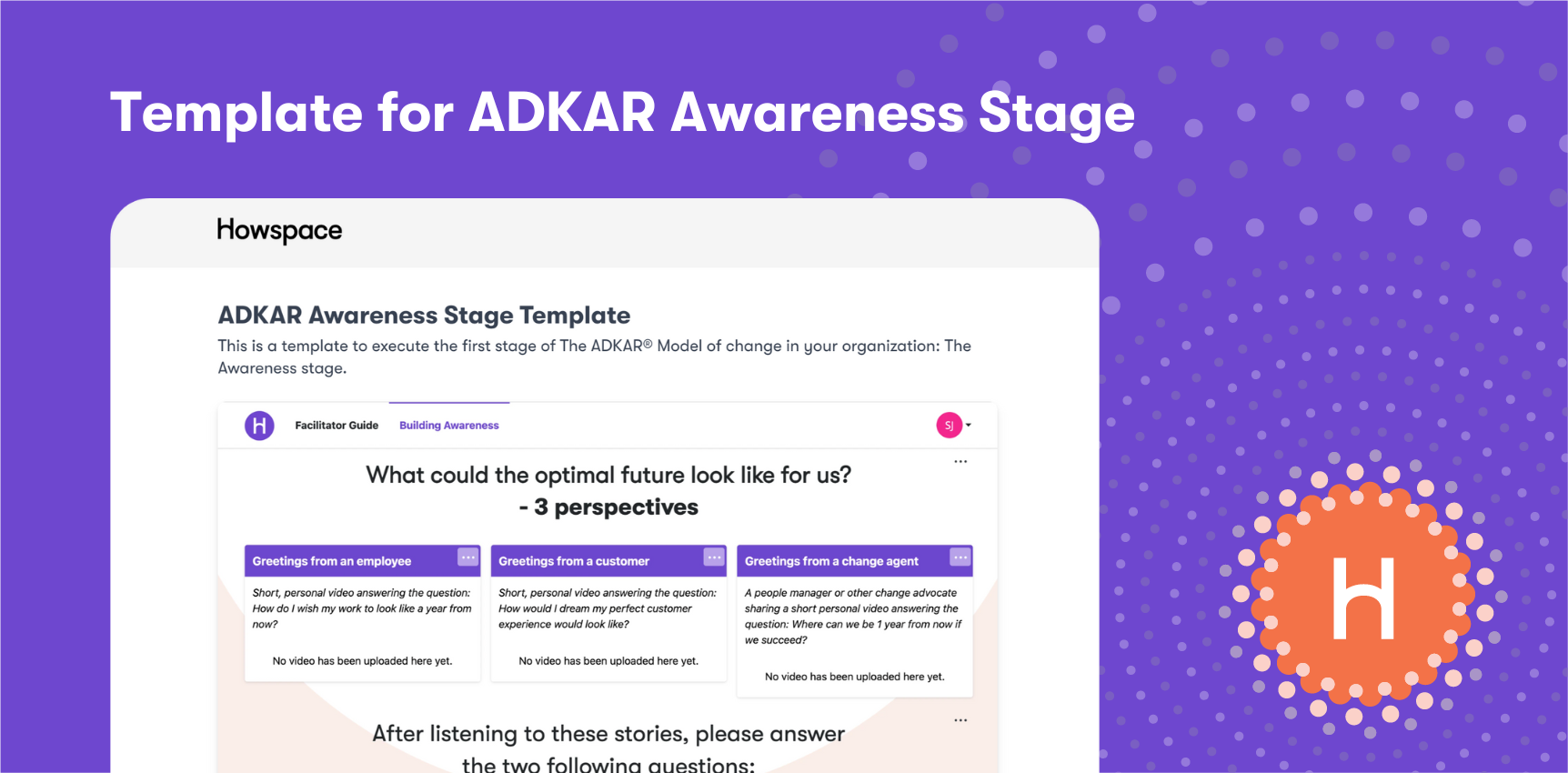
How to take the ADKAR model from theory to practice
What is the ADKAR change management model?
The ADKAR model is a well-known and widely used approach to change management that provides a framework for effectively managing change within an organization. ADKAR is an acronym that stands for Awareness, Desire, Knowledge, Ability, and Reinforcement. Each step in the ADKAR model represents a necessary condition for successful change.
But what would the ADKAR change management model look like in action?
Taking one element at a time, let’s consider how change makers can put the ADKAR model into practice.
Grab our free template for the ADKAR awareness stage and get your change process started!
1. Awareness: Communicate the reason for change
Why is change necessary? This is perhaps the most important question to answer. Without a clear reason and rationale for the change, people will have a hard time getting involved.
To create awareness for why the change is needed, communicate the rationale from different angles, preferably with personal stories. People don’t need another “bullet list”— they prefer to listen to true stories about what challenges there are in the current state and what could be achieved in the desired state.
Enabling open dialogue between people is important to have them reflect, ask questions, and share their own examples and experiences. You can also conduct video interviews with customers or employees to showcase various perspectives and make a strong case for the change.
2. Desire: Empower and engage individuals
How can you motivate people to want change?
This element of change management is complex since you can’t tell people how to feel. But there are specific reasons people might resist change. Studies show that employees can best embrace change—even if it has negative consequences—when they feel properly treated and listened to throughout the different phases of the change process.
A common mistake is to invite employees to a strategy kick-off where they are engaged in a dialogue about the change, and then not follow up afterwards. Employees are tired of writing ideas on post-its and flipcharts that they never get feedback on.
Therefore, regular communication and involvement are key to increasing the desire for change and to ensure a change resistance won’t build up due to frustration. Make your employees feel heard by inviting them to share their knowledge and experiences, giving them feedback, and answering any questions they have.
3. Knowledge: Learn by sharing
How will people contribute to the change? In order for a change to take place in your organization, employees and managers might need to acquire new in-depth knowledge or undergo new training.
No matter what knowledge individuals need, learning doesn’t happen in a vacuum. An important part of the learning process is the sharing of reflections and experiences with others. This is how we make sense of what we have learned and how we put the new knowledge into practice.
Social learning is key to spreading knowledge in your organization and create value. Don’t just send people off to a course, but make sure you have the structure and tools in place for them to implement new ideas.
4. Ability: Identify and address barriers
While knowledge is about theory and understanding, ability is all about how you can get things done.
What’s hindering people from contributing to the change? There are several reasons people might feel unable to participate. By keeping your ear to the ground, you’ll be able to identify and monitor potential barriers. Ask people how things are going, and what they’ve been working on. You might discover they don’t know how to prioritize their tasks, or they can’t get in touch with the right people. They might feel limited by their own personal skills, by time, or by structures in your organization.
As a leader, encourage people to believe in themselves and their abilities. Give people credit even if they fail, as they’ll learn from their mistakes. While it’s hard to discuss weaknesses in the workplace, make it clear that there should be no shame in asking for help.
5. Reinforcement: Keep your eye on the ball
A major challenge with organizational development is making change stick. How can you ensure things don’t go back to how they were before?
To sustain the change, keep talking about how things are progressing, celebrate milestones, and share success stories. Continuously share messages and stories about the change—whether it’s a video from a happy customer or a quotation from an employee—to ensure people understand how the change is working, and what still needs to be done.
Encourage managers to follow up with employees in 1-on-1 meetings. Give people the opportunity to talk about any obstacles that arise to ensure they can be addressed right away.
Bring it all together in one central platform
Even with these models in place, research shows it’s still incredibly difficult to succeed with change. The ADKAR change management model tells you what you need for successful change management. But you still need to know how to communicate the work to be done and effectively involve and inspire people throughout the whole process.
Howspace is a digital platform that can help you put all these building blocks into action. Participants can take an active role in the change process by using one central platform to share their thoughts and collaborate.
Check out our free template ADKAR Awareness Stage! This template will help you execute the first stage of The ADKAR® change management model in your organization and build organization-wide awareness about the reason and need for change.
Already a Howspace-user? You can add the template to your account here.

You might be interested in these as well
View all
The best change management tools for successful organizational transformation
Embracing change within organizations can be challenging, as people naturally resist it. However, utilizing the right change management software can […]

Top 7 Virtual Organizational Transformation Strategies
When it comes to organizational transformation strategies and how to effectively lead change in a virtual environment, my pro tip […]

Human-centric transformation: What is it and why does it matter?
Facilitating human-centric transformation is the skill of the future. But what exactly is human-centric transformation, and why is it so important?